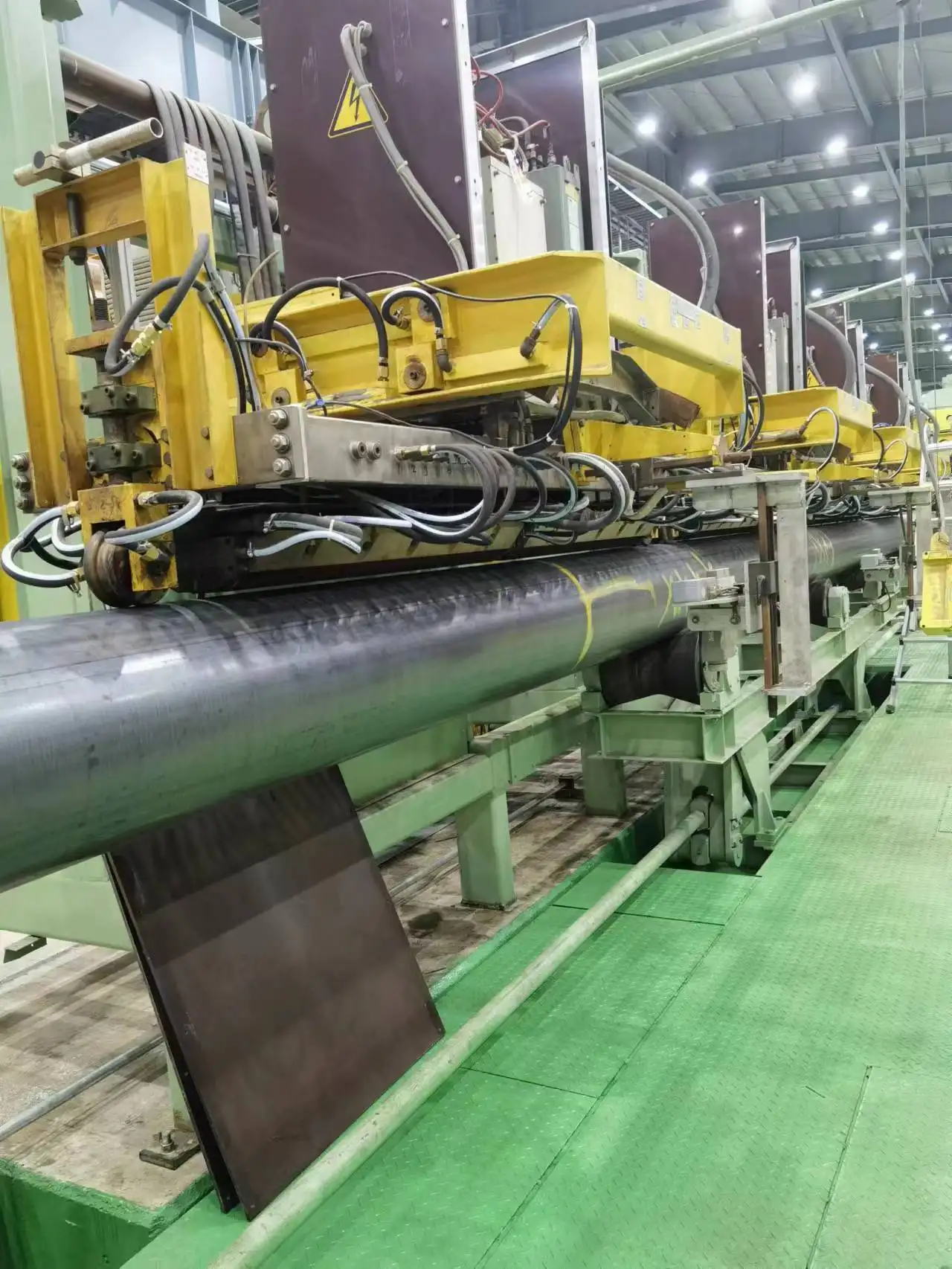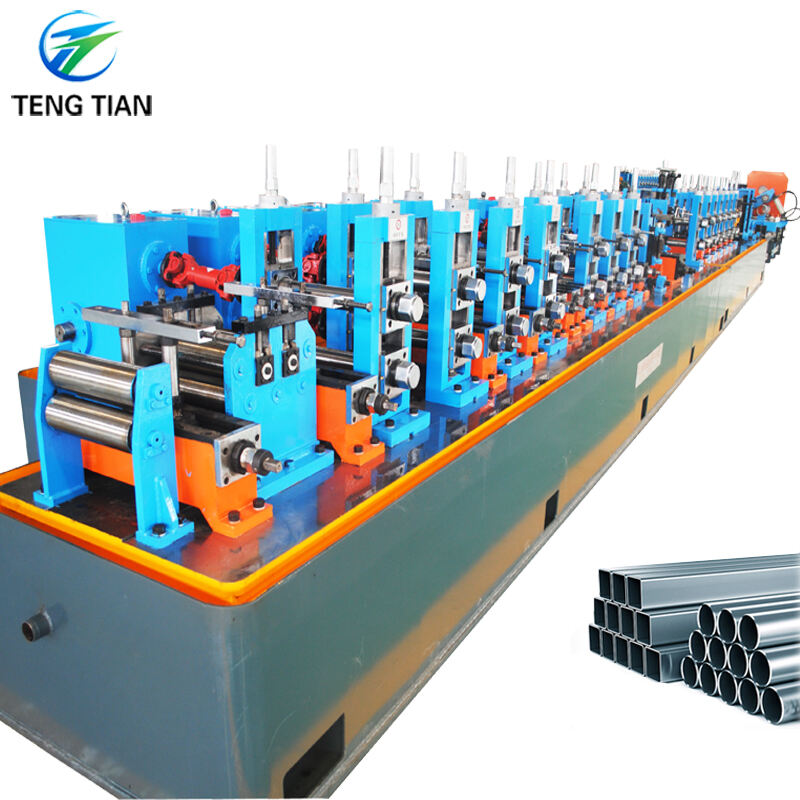ERW ပိုက်ထုတ်လုပ်မှု၏ ဗျူဟာမြောက်တန်ဖိုးကို နားလည်ခြင်း
ယနေ့ခေတ် ပြိုင်ဆိုင်မှုများပြားသော စက်မှုဇုဝ်တွင် ERW Pipe Mill သင့်စက်မှုထုတ်လုပ်မှုစွမ်းရည်ကို အခြေပြုပြောင်းလဲနိုင်သည့် အရေးပါသော ဗျူဟာမြောက်ဆုံးဖြတ်ချက်တစ်ခုကို ERW ပိုက်စက်ရုံဝယ်ယူမှုက ကိုယ်စားပြုပါသည်။ လျှပ်စစ်ဓာတ်အားဖြင့် အကွေ့အကောက်ချိတ်ဆက်ခြင်း (ERW) နည်းပညာသည် စွမ်းအင်သုံးစွဲမှု၊ တိကျမှုနှင့် စရိတ်သက်သာမှုတို့ကို ပေါင်းစပ်ပေးနိုင်ပြီး စက်မှုလုပ်ငန်းအများအပြားအတွက် ဆွဲဆောင်မှုရှိသည့် ပိုက်ထုတ်လုပ်မှုနည်းလမ်းအဖြစ် တော်လှန်မှုဖြစ်ပေါ်စေခဲ့ပါသည်။ ဤအရေးပါသောရင်းနှီးမြှုပ်နှံမှုကို မပြုလုပ်မီ သင့်စီးပွားရေးရည်မှန်းချက်များနှင့် ဈေးကွက်လိုအပ်ချက်များနှင့် ERW ပိုက်စက်ရုံသည် မည်သို့ကိုက်ညီမည်ကို နားလည်ရန် အလွန်အရေးကြီးပါသည်။
အခြေခံအဆောက်အအုံစီမံကိန်းများ တိုးချဲ့ခြင်း၊ စွမ်းအင်ကဏ္ဍတိုးတက်မှုနှင့် စက်မှုလုပ်ငန်းတိုးတက်မှုတို့ကြောင့် ERW ပိုက်များအတွက် ကမ္ဘာ့လိုအပ်ချက်များသည် ဆက်လက်တိုးမြင့်နေပါသည်။ နိုင်ငံတကာစံနှုန်းများနှင့်ကိုက်ညီသော အရည်အသွေးမြင့်ပိုက်များကို ထုတ်လုပ်ရာတွင် ယှဉ်ပြိုင်နိုင်သော ထုတ်လုပ်မှုစရိတ်ဖြင့် ထုတ်လုပ်နိုင်သည့် ယုံကြည်စိတ်ချရသော နည်းလမ်းအဖြစ် ဤထုတ်လုပ်မှုနည်းပညာသည် သက်သေပြနိုင်ခဲ့ပါသည်။
အဓိကပါဝင်ပစ္စည်းများနှင့် အခြေခံအဆောက်အအုံလိုအပ်ချက်များ
အဓိကပစ္စည်းကိရိယာများနှင့် နည်းပညာဆိုင်ရာ အသေးစိတ်အချက်အလက်များ
ERW ပိုက်စက်ရုံတစ်ခု တည်ဆောက်ရန်အတွက် ပစ္စည်းကိရိယာများ၏ အစိတ်အပိုင်းများကို ဂရုတစိုက် ထည့်သွင်းစဉ်းစားရန် လိုအပ်ပါသည်။ လုပ်ငန်း၏ အဓိကအစိတ်အပိုင်းမှာ အဖြောင့်အတိုင်း ချောမွေ့စွာ ချေါ်ဆက်နိုင်ရန် တိကျစွာ ချိန်ညှိထားသော ချေါ်ဆက်မှုစနစ်တွင် တည်ရှိပါသည်။ ခေတ်မီ ERW ပိုက်စက်ရုံများတွင် အလိုအလျောက်ထိန်းချုပ်မှု၊ အချိန်နှင့်တစ်ပြေးညီ စောင့်ကြည့်မှုစနစ်များနှင့် အရည်အသွေးစစ်ဆေးမှုကိရိယာများကဲ့သို့ နည်းပညာမြင့် အင်္ဂါရပ်များ ပါဝင်ပါသည်။
ထုတ်လုပ်မှုလိုင်းတွင် ပုံမှန်အားဖြင့် ကွန်ဒင်ဆာများ၊ စတိုင်းပြားစုပုံးများ၊ ပုံသွင်းစခန်းများ၊ ချေါ်ဆက်မှုယူနစ်များ၊ အရွယ်အစားသတ်မှတ်မှုစခန်းများနှင့် ဖြတ်တောက်မှုစနစ်များ ပါဝင်ပါသည်။ သင့်ရဲ့ ရည်ရွယ်ထုတ်လုပ်မှုစွမ်းအားနှင့် ပိုက်အသေးစိတ်အချက်အလက်များပေါ် အခြေခံ၍ အစိတ်အပိုင်းတစ်ခုစီကို ဂရုတစိုက် ရွေးချယ်ရပါမည်။ စျေးကွက်လိုအပ်ချက်များကို ကွဲပြားစွာ ဖြည့်ဆည်းပေးနိုင်ရန် ပိုက်အရွယ်အစားများနှင့် နံရံအထူများကို အသုံးပြုနိုင်သည့် ပြောင်းလဲလိုက်လျောနိုင်သော လည်ပတ်မှုကို စက်ရုံဒီဇိုင်းက ခွင့်ပြုသင့်ပါသည်။
စက်ရုံနှင့် နေရာလိုအပ်ချက်များ
ERW ပိုက်စက်ရုံအတွက် လိုအပ်သော ရုပ်ပိုင်းဆိုင်ရာ အခြေခံအဆောက်အအုံများသည် စက်ပစ္စည်းများ၏ နေရာယူမှုထက် ပိုမိုကျယ်ပြန့်စွာ လိုအပ်ပါသည်။ ပုံမှန်တပ်ဆင်မှုအတွက် ကုန်ကြမ်းသိုလှောင်ရာ၊ ထုတ်လုပ်ရေးလိုင်းများ၊ ထုတ်ကုန်သိုလှောင်ရာနှင့် အရည်အသွေးထိန်းချုပ်မှုစနစ်များအတွက် လုံလောက်သော နေရာလိုအပ်ပါသည်။ အဆောက်အဦအတွင်းတွင် ကရိန်းများနှင့် ပစ္စည်းများကို ကိုင်တွယ်ရာစနစ်များအတွက် သတ်မှတ်ထားသော အမြင့်ရှိရန် လိုအပ်ပြီး ကြမ်းပြင်များကို စက်ကိရိယာကြီးများနှင့် ထုတ်ကုန်များ ရွေ့လျားမှုကို ခံနိုင်ရည်ရှိစေရန် ဒီဇိုင်းထုတ်ထားရပါမည်။
သဘာဝပတ်ဝန်းကျင်ဆိုင်ရာ ထည့်သွင်းစဉ်းစားမှုများကလည်း အရေးပါသော အခန်းကဏ္ဍမှ ပါဝင်ပါသည်။ ထိုသို့သော ထည့်သွင်းစဉ်းစားမှုများတွင် သင့်တော်သော လေအောက်ခံစနစ်၊ အပူချိန်ထိန်းချုပ်မှုနှင့် စွန့်ပစ်ပစ္စည်းစီမံခန့်ခွဲမှုစနစ်များ ပါဝင်ပါသည်။ အရေးကြီးပစ္စည်းများပတ်လည်ရှိ နေရာချဲ့ထွင်နိုင်မှုနှင့် ပြုပြင်ထိန်းသိမ်းရေးဝင်ရောက်နိုင်မှုနေရာများကို အနာဂတ်တွင် ဖြစ်ပေါ်လာနိုင်မည့် အခြေအနေများအတွက် အစီအစဉ်ချမှတ်ရာတွင် ထည့်သွင်းစဉ်းစားသင့်ပါသည်။
ဘဏ္ဍာရေးဆိုင်ရာ သက်ရောက်မှုများနှင့် ရင်းနှီးမြှုပ်နှံမှုမှ ပြန်အမ်းရရှိမှု
အစောဆုံးရင်းနှီးမြှုပ်နှံမှု အချက်အလက်များ
ERW ပိုက်စက်ရုံအတွက် မူလရင်းနှီးမြှုပ်နှံမှုသည် ထုတ်လုပ်မှုစွမ်းရည်၊ အလိုအလျောက်စနစ်အဆင့်နှင့် အသေးစိတ်အချက်အလက်များပေါ်တွင် မူတည်၍ သိသိသာသာကွဲပြားနိုင်ပါသည်။ စက်ပစ္စည်းကုန်ကျစရိတ်များအပြင် စီးပွားရေးလုပ်ငန်းများသည် စက်ရုံနေရာပြင်ဆင်မှု၊ အသုံးပြုမှုဆိုင်ရာ စနစ်များတပ်ဆင်မှုနှင့် လုပ်သားများအား လေ့ကျင့်ပေးမှုဆိုင်ရာ ကုန်ကျစရိတ်များကိုပါ ထည့်သွင်းစဉ်းစားရန် လိုအပ်ပါသည်။ မြေယာဝယ်ယူမှုမှ စည်းမျဉ်းလိုက်နာမှုတို့အထိ တိုက်ရိုက်နှင့် indirect ကုန်ကျစရိတ်များအားလုံးကို ထည့်သွင်းတွက်ချက်သော စနစ်တကျ ငွေကြေးဆိုင်ရာ ခွဲခြမ်းစိတ်ဖြာမှုကို ပြုလုပ်သင့်ပါသည်။
လည်ပတ်မှုအတွက် လိုအပ်သော အလုပ်ရှင်ရင်း (working capital) တွင် ကုန်ကြမ်းပစ္စည်းများ စုဆောင်းထားမှု၊ လည်ပတ်စရိတ်များနှင့် အစပိုင်း ထုတ်လုပ်မှုတိုးတက်လာသည့် ကာလကို ထည့်သွင်းတွက်ချက်ရပါမည်။ စနစ်တည်ဆောက်မှုနှင့် အစောပိုင်း လည်ပတ်မှုကာလအတွင်း မမျှော်လင့်ပဲ ကြုံတွေ့နိုင်သော အခက်အခဲများအတွက် အရန်ငွေများ ထည့်သွင်းတွက်ချက်ခြင်းဖြင့် ဂရုတစိုက် ငွေကြေးအစီအစဉ်ရေးဆွဲသင့်ပါသည်။
လည်ပတ်မှုစရိတ် ထည့်သွင်းစဉ်းစားရမည့်အချက်များ
ERW ပိုက်စက်ရုံ လည်ပတ်မှုတွင် အမြတ်အစွန်းကို တိုက်ရိုက်သက်ရောက်မည့် လုပ်ဆောင်မှုစရိတ်များ ပါဝင်ပါသည်။ ဓာတ်အားသုံးစွဲမှုမှာ ထင်ရှားသော ကုန်ကျစရိတ်ဖြစ်ပြီး အထူးသဖြင့် ချောမွေ့သော ပေါင်းစပ်မှုလုပ်ငန်းစဉ်တွင် ဖြစ်ပါသည်။ အလိုအလျောက်စနစ် အဆင့်နှင့် ဒေသတွင်းဈေးကွက်အခြေအနေများပေါ် မူတည်၍ လုပ်သားစရိတ်များ ကွဲပြားပြီး စက်ပစ္စည်းများ၏ စံပြအစွမ်းထက်မှုကို ထိန်းသိမ်းရန် ထိန်းသိမ်းမှုစရိတ်များကို ဂရုတစိုက် ဘတ်ဂျက်ချထားရန် လိုအပ်ပါသည်။
ကုန်ပစ္စည်းများ၏ ဈေးနှုန်းများမှာ ဈေးကွက်အခြေအနေများနှင့်အတူ ပြောင်းလဲနေပြီး အမြတ်နှုန်းများ ထိန်းသိမ်းရန် ဗျူဟာမြောက် ဝယ်ယူမှုများ အရေးပါပါသည်။ အခြားထည့်သွင်းစဉ်းစားရမည့် အချက်များတွင် အရည်အသွေးထိန်းချုပ်မှုစရိတ်၊ အသိအမှတ်ပြုမှုစရိတ်နှင့် နည်းပညာပိုင်းဆိုင်ရာ ဝန်ထမ်းများအတွက် ဆက်လက်လေ့ကျင့်ပေးရမည့် လိုအပ်ချက်များ ပါဝင်ပါသည်။
ဈေးကွက်အခွင့်အလမ်းများနှင့် စီးပွားရေး အလားအလာ
စက်မှုလုပ်ငန်း အသုံးချမှုများနှင့် ဝယ်လိုအား ဆန်းစစ်ခြင်း
ERW ပိုက်များသည် ဆောက်လုပ်ရေး၊ ရေနံနှင့် သဘာဝဓာတ်ငွေ့၊ ရေပို့ဆောင်ရေး၊ ဖွဲ့စည်းပုံအသုံးပြုမှုများ အပါအဝင် ကဏ္ဍများစွာတွင် အသုံးဝင်ပါသည်။ သင့်စျေးကွက်၏ သတ်မှတ်ထားသော လိုအပ်ချက်များနှင့် ကြီးထွားနိုင်မှုကို နားလည်ခြင်းသည် အောင်မြင်သော စီးပွားရေး အစီအစဉ်ချမှတ်မှုအတွက် အလွန်အရေးကြီးပါသည်။ စျေးကွက်သုတေသနသည် ကဏ္ဍအလိုက် လက်ရှိလိုအပ်ချက်များနှင့် ပေါ်ပေါက်လာသော အခွင့်အလမ်းများကို ထောက်ဖော်သတ်မှတ်ရန် လိုအပ်ပါသည်။
ဒေသအတွင်း အခြေခံအဆောက်အအုံဖွံ့ဖြိုးရေးစီမံကိန်းများ၊ စက်မှုလုပ်ငန်းတိုးတက်မှုနှင့် ရှိပြီးသား စနစ်များတွင် အစားထိုးလိုအပ်မှုတို့သည် ဈေးကွက်အလားအလာကို အားပေးပါသည်။ ဤအချက်များကို ဆန်းစစ်ခြင်းဖြင့် ERW ပိုက်စက်ရုံအတွက် သင့်တော်သော ထုတ်လုပ်မှုစွမ်းရည်နှင့် ထုတ်ကုန်အသေးစိတ်အချက်အလက်များကို ဆုံးဖြတ်နိုင်ပါသည်။
ယှဥ်ပြိုင်မှု နေရာချထားမှု ဗျူဟာများ
ERW ပိုက်ဈေးကွက်တွင် အောင်မြင်ရန် ရှင်းလင်းသော ကွဲပြားခြားနားမှု ဗျူဟာများနှင့် အားကောင်းသော ဈေးကွက်တည်နေရာကို လိုအပ်ပါသည်။ အရည်အသွေး အတည်ပြုချက်၊ နည်းပညာဆိုင်ရာ ပံ့ပိုးမှုစွမ်းရည်များနှင့် ယုံကြည်စိတ်ချရသော ပို့ဆောင်ရေးစနစ်များသည် သင့်လုပ်ငန်းကို ယှဉ်ပြိုင်ဖက်များထက် ကွဲပြားစေနိုင်ပါသည်။ အဓိက စားသုံးသူများနှင့် လုပ်ငန်းအဖွဲ့ဝင်များနှင့် ဆက်ဆံရေးတည်ဆောက်ခြင်းဖြင့် တည်ငြိမ်သော ဈေးကွက်တည်ရှိမှုကို တည်ထောင်ရာတွင် အထောက်အကူဖြစ်စေပါသည်။
အထူးပြု အလွှာများ သို့မဟုတ် စိတ်ကြိုက် အသေးစိတ်အချက်အလက်များကဲ့သို့သော ထုတ်ကုန်များတွင် တီထွင်ဆန်းသစ်မှုများသည် ဈေးကွက်အပိုင်းအစ အသစ်များကို ဖွင့်လှစ်ပေးနိုင်ပါသည်။ အမြဲတမ်း အရည်အသွေးနှင့် ယုံကြည်စိတ်ချရသော ဝန်ဆောင်မှုအတွက် ဂုဏ်သတင်းတည်ဆောက်ခြင်းသည် ရေရှည်လုပ်ငန်း တည်တံ့ခိုင်မြဲမှုကို ပံ့ပိုးပေးပါသည်။

လုပ်ငန်းဆောင်တာ ထူးချွန်မှုနှင့် အရည်အသွေးစီမံခန့်ခွဲမှု
ထုတ်လုပ်မှုလုပ်ငန်းစဉ်ကိုအကောင်အထည်ဖော်ခြင်း
ERW ပိုက်စက်ရုံတစ်ခု၏ ထိရောက်သော လည်ပတ်မှုသည် လုပ်ငန်းစဉ် အကောင်းဆုံးဖြစ်အောင် ပြုလုပ်ခြင်းနှင့် အရည်အသွေးထိန်းချုပ်မှုကို ဂရုတစိုက် လိုအပ်ပါသည်။ ခေတ်မီသော စက်ရုံများတွင် ထုတ်လုပ်မှု ပါရာမီတာများကို တသမတ်တည်း ထိန်းသိမ်းပေးပြီး အ waste ပစ္စည်းများကို လျော့နည်းစေရန် အဆင့်မြင့် အလိုအလျောက်စနစ်များ ပါဝင်ပါသည်။ ပေါင်းဆက်မှု ပါရာမီတာများကို ပုံမှန်စောင့်ကြည့်ခြင်းနှင့် ညှိနှိုင်းခြင်းဖြင့် အကောင်းဆုံး ပေါင်းဆက်မှုအရည်အသွေးကို သေချာစေပြီး ချို့ယွင်းချက်များကို အနည်းဆုံးဖြစ်အောင် လျှော့ချပေးပါသည်။
လိပ်စားထုတ်လုပ်မှု အခြေခံမူများကို အကောင်အထည်ဖော်ခြင်းသည် ထိရောက်မှုကို မြှင့်တင်ပေးပြီး လည်ပတ်မှုကုန်ကျစရိတ်များကို လျှော့ချနိုင်ပါသည်။ ၎င်းတွင် ပစ္စည်းများ စီးဆင်းမှုကို အကောင်းဆုံးဖြစ်အောင်ပြုလုပ်ခြင်း၊ စတင်ပြင်ဆင်မှုကာလများကို အနည်းဆုံးဖြစ်အောင်လုပ်ဆောင်ခြင်းနှင့် ထိရောက်သော ကုန်ပစ္စည်းစီမံခန့်ခွဲမှုစနစ်များကို ထိန်းသိမ်းထားခြင်းတို့ ပါဝင်ပါသည်။
အရည်အသွေး အာမခံစနစ်များ
ERW ပိုက်ဈေးကွက်တွင် အောင်မြင်မှုရရှိရန်အတွက် အရည်အသွေးမြင့်မားမှုကို ထိန်းသိမ်းခြင်းသည် အလွန်အရေးကြီးပါသည်။ ပြည့်စုံသော အရည်အသွေးစီမံခန့်ခွဲမှုစနစ်တွင် ပစ္စည်းများ လက်ခံစဉ် စစ်ဆေးခြင်း၊ ထုတ်လုပ်စဉ် ထိန်းချုပ်မှုများနှင့် နောက်ဆုံးထုတ်ကုန် စမ်းသပ်မှုများ ပါဝင်သင့်ပါသည်။ အယ်လ်ထရာဆောင်းနစ်စနစ်များနှင့် ဟိုက်ဒရိုစတက်တစ်စမ်းသပ်မှုစနစ်များကဲ့သို့သော ခေတ်မီစမ်းသပ်ကိရိယာများသည် ထုတ်ကုန်၏ ယုံကြည်စိတ်ချရမှုကို သေချာစေပါသည်။
စာရွက်စာတမ်းနှင့် ခြေရာခံနိုင်သောစနစ်များသည် အရည်အသွေးအတွက် အတည်ပြုချက်လိုအပ်ချက်များနှင့် ဖောက်သည်များ၏ အသေးစိတ်လိုအပ်ချက်များကို ပံ့ပိုးပေးပါသည်။ စမ်းသပ်ကိရိယာများကို ပုံမှန် ဂျီဩမီတာတိုင်းကိရိယာဖြင့် စစ်ဆေးညှိနှိုင်းခြင်းနှင့် ဝန်ထမ်းများအား ဆက်လက်လေ့ကျင့်ပေးခြင်းတို့သည် အရည်အသွေး တည်ငြိမ်မှုကို ထိန်းသိမ်းပေးပါသည်။
မေးလေ့ရှိသောမေးခွန်းများ
ERW ပိုက်စက်ရုံ ရင်းနှီးမြှုပ်နှံမှုအတွက် ပုံမှန်ပြန်လည်ရရှိမှုကာလသည် မည်မျှရှိပါသလဲ။
ERW ပိုက်စက်ရုံ၏ ရင်းနှီးမြှုပ်နှံမှု ပြန်လည်ရရှိသည့် ကာလသည် ဈေးကွက်အခြေအနေ၊ စွမ်းဆောင်ရည်အသုံးပြုမှုနှင့် လည်ပတ်မှု ထိရောက်မှုပေါ် မူတည်၍ ပုံမှန်အားဖြင့် ၃ နှစ်မှ ၅ နှစ်အထိ ကွာခြားနိုင်ပါသည်။ ရင်းနှီးမြှုပ်နှံမှုမှ အမြတ်အစွန်းရရှိမှုကို သက်ရောက်မှုရှိသော အချက်များတွင် ထုတ်လုပ်မှုပမာဏ၊ ဈေးကွက်စျေးနှုန်းသတ်မှတ်ခြင်းနှင့် လည်ပတ်စရိတ်များ ပါဝင်ပါသည်။
ERW ပိုက်၏ အရည်အသွေးကို ဆီလျော်သော ပိုက်များနှင့် ဘယ်လိုနှိုင်းယှဉ်ရမလဲ။
ခေတ်မီနည်းပညာဖြင့် ထုတ်လုပ်ထားသော ERW ပိုက်များသည် အသုံးပြုမှုအများအပြားအတွက် အရည်အသွေးကောင်းမွန်ပြီး ယုံကြည်စိတ်ချရမှုရှိပါသည်။ အမြင့်ဆုံးဖိအား သို့မဟုတ် အရေးကြီးသော အသုံးပြုမှုအတွက် ဆီလျော်သော ပိုက်များကို ဦးစားပေးရန် လိုအပ်နိုင်သော်လည်း ERW ပိုက်များသည် နိုင်ငံတကာစံနှုန်းများနှင့် ကိုက်ညီပြီး စက်မှုလုပ်ငန်းလိုအပ်ချက်အများစုအတွက် စရိတ်သက်သာသော ဖြေရှင်းနည်းများကို ပေးဆောင်ပါသည်။
ERW ပိုက်စက်ရုံကို လည်ပတ်ရန် အဆင့်မြင့် နည်းပညာဆိုင်ရာ ကျွမ်းကျင်မှု မည်မျှလိုအပ်ပါသလဲ။
ERW ပိုက်စက်ရုံကို လည်ပတ်ရန်အတွက် ကွန်ရက်နည်းပညာ၊ အရည်အသွေးထိန်းချုပ်မှုနှင့် စက်ပစ္စည်းများ ထိန်းသိမ်းမှုတို့တွင် ကျွမ်းကျင်သော ဝန်ထမ်းများ လိုအပ်ပါသည်။ အကောင်းဆုံးလည်ပတ်မှုအတွက် စနစ်တကျ လေ့ကျင့်သင်ကြားပေးမှု အစီအစဉ်နှင့် အတွေ့အကြုံရှိသော နည်းပညာဆိုင်ရာ ကြီးကြပ်မှုများ မရှိမဖြစ် လိုအပ်ပါသည်။
အကြောင်းအရာများ
- ERW ပိုက်ထုတ်လုပ်မှု၏ ဗျူဟာမြောက်တန်ဖိုးကို နားလည်ခြင်း
- အဓိကပါဝင်ပစ္စည်းများနှင့် အခြေခံအဆောက်အအုံလိုအပ်ချက်များ
- ဘဏ္ဍာရေးဆိုင်ရာ သက်ရောက်မှုများနှင့် ရင်းနှီးမြှုပ်နှံမှုမှ ပြန်အမ်းရရှိမှု
- ဈေးကွက်အခွင့်အလမ်းများနှင့် စီးပွားရေး အလားအလာ
- လုပ်ငန်းဆောင်တာ ထူးချွန်မှုနှင့် အရည်အသွေးစီမံခန့်ခွဲမှု
- မေးလေ့ရှိသောမေးခွန်းများ

